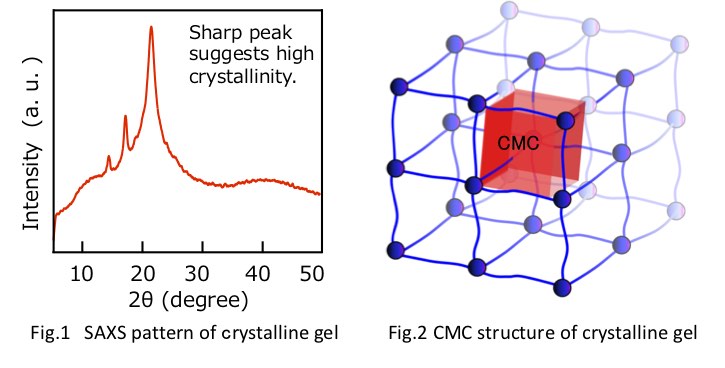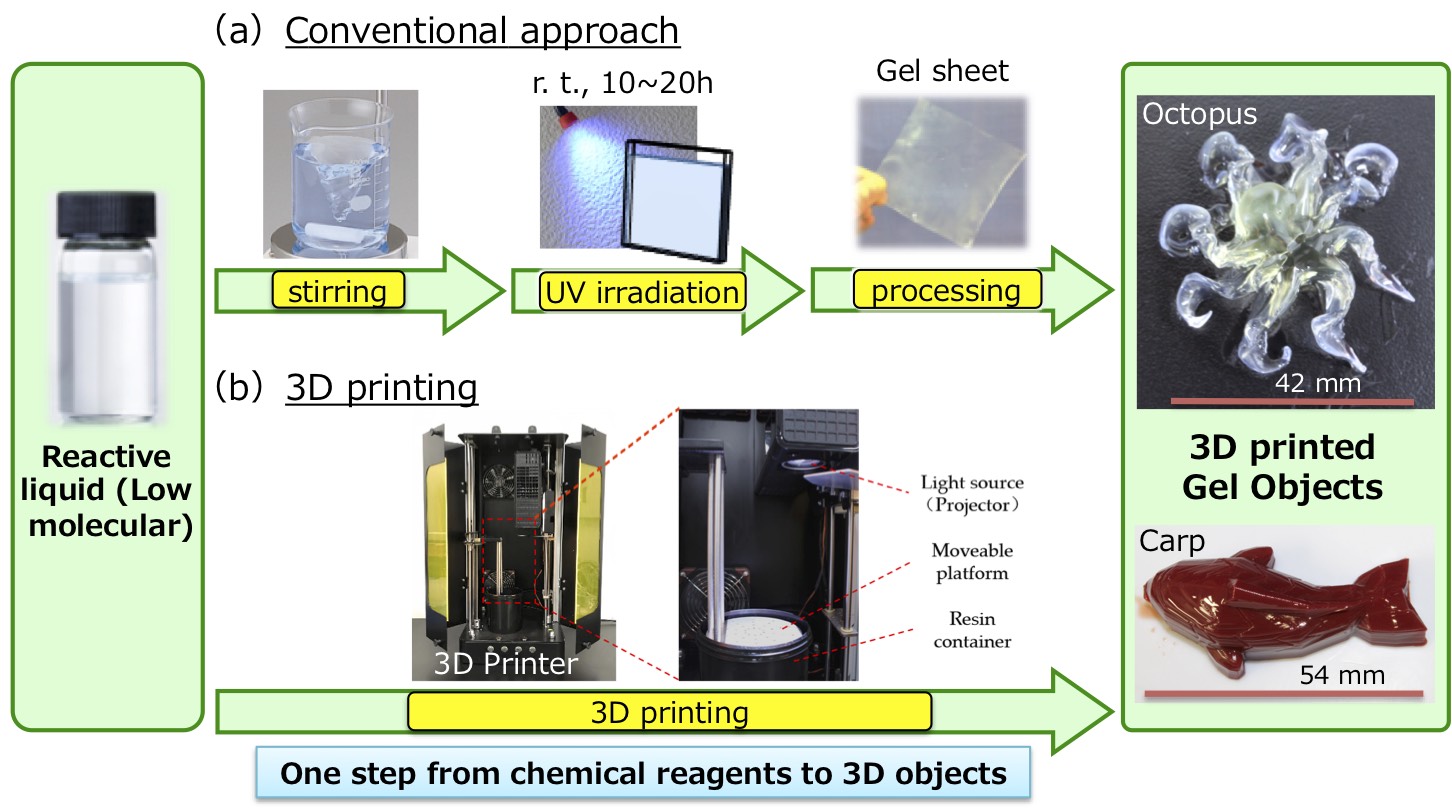Soft Crosslinking Materials Laborary
Department of Polymeric and Organic Materials Engineering, Graduate School of Organic Materials Science, Yamagata University
Subject 1
Artificial gel skin and tissue for soft robots
Gel is a kind of material that has the most similar propeties to biomedical tissue. From this view point, we have been taken much efforts to develop artificial gel skin and tissue for robots. The properties of gel skin and tissue, including softness, flexibility, sthength, surface roughness, color, etc., are adjustable depending on the intended use and operating environment.
Subject 2
Toughening and transparentizing of crystalline gel by controling the structure of crystalline mesh capsule (CMC)
Our research interest is centered around the synthesis and applications of high-performance crystalline gels. Crystalline gels have high crystallinity, and their structure are specially designed to introduce crystalline component into the three-dimentional mesh structure. The three-dimentional mesh structure and high crystallinity generates a novel innerstructure --- Crystalline Mesh Capsule, short for CMC (Fig.2). The CMC is composed of mesh structure derived from main chains (shell) and crystal structure derived from side chains (core). The shell beneficially provides good mechanical properties, as as high strength, high flexibity. The core largely contributes to functionality, like temperature-responsivity, shape memory, thermal energy (heat/cold) storage etc. By changing the CMC structure through molecular design, crystalline gels with desirable mechanical properties and functionality can be prepared. The Wide Angle X-ray Scattering (WAXS) patten for a crystalline gel shows it has high crystallinty (Fig.1).We are also chanlleging the synthesis and application of crystaline gel particle, crystalline gel fiber, crystalline gel nonwoven faric, thermalsensitive shrinkage film and crystalline gel micro-/nano-porous membrane, etc.


[1] Yuchen Mao, Jin Gong, Meifang Zhu, Hiroshi Ito, Polymer 2018, 150, 267-274.
DOI: org/10.1016/j.polymer.2018.07.040.
[2] Jin Gong, Eiichi Hosaka, Kohei Sakai, Hiroshi Ito, Yoshikazu Shibata, Kosei Sato, Dai Nakanishi, Shinichiro Ishihara and Kazuhiro Hamada, Polymers 2018, 10 (5), 486, 1-14.
DOI: 10.3390/polym10050486.
Subject 3
3D printing of crystalline gels with excellent mechanical properties and multiple functionality
Since developed in 1980s, three-dimensional (3D) printing, also known as additive manufacturing (AM), has been presented in art, architecture, tissue engineering, biomedical devices and manufacturing, such as rapid pattern making and rapid tooling using printing technologies [9-12]. 3D printing technology provides a possible method to manufacture objects with complex and precise structures, and unique physical properties for archiving optimal performance. By ingenious design, 3D printing subjects can improve initial properties and get more structure functions [15,16]. Fused decomposition modeling, selective laser sintering, stereolithography (SLA) and 3D plotting/ direct-writing/ bioprinting are the common 3D printing methods. Among all, we are most interested in mask-projection SLA, which is an easy and quick 3D printing method using liquid ultraviolet (UV) curable photo-polymer and a UV laser to build solid objects by printing thin layers on one top of the other. The advantages of SLA are the ability to create complex shapes with internal architectures, ease of removal of unpolymerized resin and extremely high feature resolution (~1.2 μm).In our group, much of the work revolves around crystalline gels. We have developed crystalline gels with high toughness, high flexibility, and functions as shape memory, humidity regulation, thermal expansion and thermal energy storage, etc. These crystalline gels are synthesized by radical photo-polymerization that involves photo-reactive reagents having the property of curing from liquid to solid with light of a sufficient energy. Note that the mask-projection SLA uses the same principle of photo-polymerization as the synthesis of crystalline gels. Therefore, we are interested in the 3D printing of crystalline gels in order to make their three-dimensional objects directly from the reactive liquid resin.

[1] Yuchen Mao, Takuya Miyazaki, Kohei Sakai, Jin Gong*, Meifang Zhu*, Hiroshi Ito*, Polymers 2018, Preprint http://www.preprints.org/manuscript/201809.0114/v1
[2] Takashi Hoshiba and Jin Gong, Microsystem Technologies 2017, 24(1), 613-617. DOI: 10.1007/s00542-017-3470-1.
